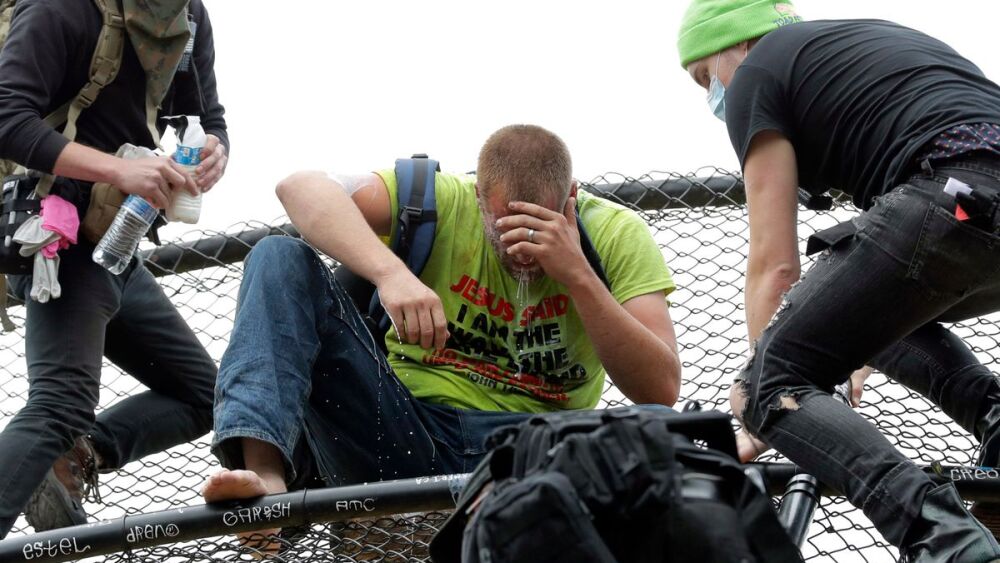In this current era of civil disorder, the medic on the truck staging around the block isn’t the only “medic” in the vicinity. Recent protests and demonstrations have all involved “street medics,” identifying themselves with their duct tape red crosses as part of the organization of the protests. We have all seen the YouTube videos of administering a tourniquet for a scratch to the leg, or dispensing supermarket milk in the treatment of tear gas, but who are these street medics? What do they do, and importantly, do they have any legal protection, recognition or certified skills?
It turns out that the existence of street medics in support of those exercising their amendment rights is not new and goes back to the civil rights movement. Many resources chart their history, training and motivation. This is a very emotive subject for EMS as the term “medic” alone conjures up an expectation of qualification, certification and experience. It is also a point of annoyance to some in EMS that street medics are even present and taking part in highly volatile events.
But as a scholar of all things EMS, I wish to understand how street medics operate and what they undertake to deliver. The old soldier in me demands that I am also familiar with their doctrine, tactics, techniques and procedures.
Street medics came into the spotlight recently after a lawsuit in Portland, Oregon, in which representative plaintiffs sought a temporary restraining order (TRO) to protect them from arrest, having physical force used against them, being dispersed, having their equipment seized, or being ordered to move or to stop treating an individual. The request, similar in structure to the Geneva Convention, provides that “medical and hospital personnel shall be respected and protected.” Before we arrive at the ruling on this case, it is worth understanding street medics a little deeper.
What is a street medic?
In the words of the various street medics’ own publications, street medics, or action medics, are volunteers with a minimum of first aid medical training supplemented by specific protest-related training, who attend protests and demonstrations as support or mutual aid roles to provide medical and wellness care. Unlike EMTs or paramedics, who have undergone education for professional medical care, street medics usually operate under Good Samaritan laws and use methods learned through specific protest-medicine training programs that individuals are required to undertake to be recognized as a trained street medic.
Street medic training and equipment
To better understand street medic training, I reviewed a Do No Harm Coalition (a street medic group formed in 2016 in San Francisco) video class, “Street Medic - Bridge Training for Medical Professionals” on YouTube. The curriculum – aimed at existing clinical professionals considering joining in with protest coverage – explained a wide range of topics, from preparation for street medicine and situational awareness, to riot injury patterns, self-care, and “police violence as a public health threat.” The class stressed the importance of operating in a buddy system and never becoming separated, as well as writing the legal aid number with a sharpie on the body in case of arrest.
The video provided guidance on what to wear, including helmets, running shoes and backpacks containing snacks and water. Other essential equipment also included heat-resistant gloves to move tear gas canisters as well as loose change for the subway. Medical students were invited to show up carrying extra masks and gloves to share because of the COVID-19 threat – no indication was given of where this equipment was to be sourced from.
Instructors were clear that despite the certification of clinicians volunteering to serve, that use of BLS skills only should be employed on the ground. The instructor advised that he “strongly advised refraining from doing the thing you may know how to do in the streets” and went on to note, “you don’t need to be going to trach anyone or put a chest tube in - we are not there yet.” For non-clinical volunteers, a 20-hour basic class is conducted which includes comprehensive coverage of BLS interventions as well as an understanding of mental, behavioral health and peer support issues.
What the Street Medics say about EMS
The street medics training video included comments about public safety EMS which were perhaps fair – we do have to follow the IAP and stage as required as scene safety and provider protection are major considerations in our own EMS delivery doctrine. The instructor asked the class to “think of the last time you saw an ambulance there attending to wounded people subjected to chemical weapons and kinetic injuries.” They observed that EMS comes to the scene later. This reinforced the rationale for street medicine being in place to temporize, stabilize and treat until the patient can get to a higher level of care.
Street medics and lawful orders: The verdict
Returning to the case of Wise, Martinez, Durkee, and Guest (the medics/plaintiffs) vs. the City of Portland, in a 23-page ruling, District Judge Karin J. Immergut denied the motion and concluded that in so ruling, the medics had no unique status under the First Amendment that allows them to disregard lawful orders. “This court does not seek to diminish or devalue the efforts of the protest medics in keeping others safe, nor does this court question the protest medics’ right to continue engaging in the protests and offering medical support to protesters. Like ordinary protesters, however, the protest medics must abide by lawful police orders,” the ruling stated. The ruling also found that, “in many of the incidents of alleged targeting described, the protest medics were not in the act of providing medical aid.”
Good Samaritans?
To offer a balanced view of this topic, I realize that we in the uniformed services delivering EMS, have never, to my knowledge been requested or volunteered to provide medical standby for a protesting organization. By virtue of that fact, we have been, for the most part, in the second echelon of the scene, awaiting clearance and call forward to the incident to render care. On the other side of the divide, shields and barriers, groups have formed, sympathetic to the demonstration and demonstrator, to offer some degree of response and care voluntarily. These individuals, no matter what we think, are acting as Good Samaritans and as such enjoy protections for those administering aid. They are, however, citizens, and currently appear to have no exemption from lawful orders.
On the question of competency to practice, or delivering EMS without a license, I can find no opinion to outlaw or question this. Similarly, I can find no evidence of certified clinicians who have served as street medics being disciplined or de-registered either. Nor can I find any examples of an injured protester litigating against a street medic for an act of gross negligence.
In the final analysis, street medics are out there on the other side of the line, doing what they are legally allowed to do, and perhaps we should not be concerned unless it directly affects our practice or stops us from delivering certified and authorized care on the scene.
Street Medics: EMS ONE-STOP WITH ROB LAWRENCE
For an audio version of this article, listen below.
Read more
Scene safety and responding to civil unrest
Six takeaways from the USFA, NHTSA best practices to protect fire and EMS providers responding to incidents of civil unrest














